Buzzards Bay Oil Spill Volume Evaluations
Related pages: Oil Spill Costs | Past Spills
Special Note:
US Coast Guard concluded 98,000 gallons was the best estimate of No. 6 oil spilled in Buzzards Bay.
This page summarizes details of the changing estimates of oil spilled, and the basis of the various oil spill volume calculations. In 2003 and 2004, an unresolved question about the spill had been, which volume of oil spilled was the best estimate:
- the 98,000 gallon estimate by the oil auditing firm Caleb Brett Intertek based on water and oil levels on the Bouchard No. 120 in Buzzards Bay the day after the accident,
- the 168,000 gallons unaccounted for oil after the Bouchard No. 120 and the vessel that assisted it after the spill, the Bouchard No. 10 offloaded their oil at the Mirant power generating facility days after the accident, or
- the 22,000 to 55,000 gallon estimate made by Bouchard Transportation Company’s consultant (Independent Maritime Consulting Ltd.) based on measurements several weeks later of residual oil from a hot wash cleaning of all compartments of the damaged Bouchard No. 120, and based on measurements and calculations of oil and water transferred based on transfers between 3 tank barges and 3 shore tanks in New York, in comparison to its original cargo and oil delivered to Mirant.
The 22,000-gallon estimate was a straw-man minimum loss calculation that was not applicable to the actual accident conditions and events in Buzzards Bay. The Buzzards Bay NEP found the 55,000 gallon estimate by Independent Maritime Consulting Ltd. contained many weaknesses, there were so many transfers between vessels an onshore tanks, and so many assumptions were needed, that their methods introduced many errors into the calculation.
Our concerns were summarized in an April 16, 2004 Buzzards Bay NEP letter to the Coast Guard (81 kb pdf file). On June 29, 2004, in a memorandum to the Coast Guard MSO Providence (208 kb pdf file), the US Coast Guard Marine Safety Office in Washington, D.C. concluded that the Caleb Brett Intertek 98,000 gallon determination was the most credible estimate of oil spilled. This volume makes the Bouchard No. 120 the second largest spill recorded for Buzzards Bay.
Original oil volume estimate reports and chemical analyses: original-ullage-reports.zip.
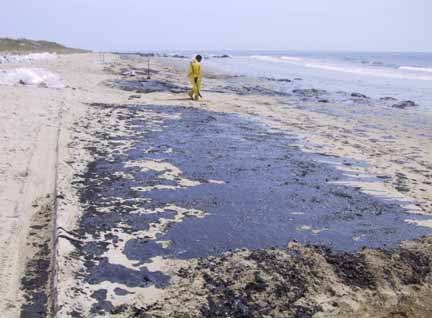
This photo of a worker holding a shovel was taken on April 29, 2003 during the cleanup of oil at Barney’s Joy. Some areas in the photo have had the oil already removed with shovels, and placed in bags which were hauled away.
Estimates of Oil Volumes
Within a few hours of the Bouchard No. 120 accident on April 27, in a helicopter survey around dusk, federal officials observed only a sheen of oil in Buzzards Bay south of the anchored vessel. Because only a sheen (a very thin layer) was observed, these officials concluded that perhaps less than 1,000 gallons of oil might have been spilled. That night, however, divers discovered a 12-foot by 2-foot rupture on the bottom of the tank barge. Apparently based on inspection of tanker compartment oil levels that night, it was estimated that 14,700 gallons of Number 6 oil were spilled, and government officials released this volume estimate on April 28. However, this estimate was incorrect, because there was a large amount of water instead of oil in two of the tanks that had not been accounted for.
The day after the accident, while the damaged vessel was anchored in Buzzards Bay, an independent auditing company called Caleb Brett Intertek made measurements of the precise amount of oil and water in each compartment. Caleb Brett Intertek is one of the companies that takes measurements on tankers before and after receipt of oil from refineries, and before and after delivery of oil to their customers, in this case, the Mirant power station in the Cape Cod Canal. Caleb Brett’s services are provided to make sure the buyers, sellers, and transporters of oil are in agreement as to how much oil is being transacted.
Caleb Brett estimated that the actual volume spilled was approximately 98,000 gallons. On May 21 the press reported that the Bouchard Transportation Company had concluded that the actual volume spilled was 98,000 gallons. Caleb
In the days after the accident, the Bouchard No. 120, and another vessel that assisted it in off loading oil, the Bouchard No. 10 delivered their oil to Mirant. Caleb Brett again measured the volume of oil in both vessels before and after delivery. This time, the amount of oil unaccounted for was 168,000 gallons. However, the problem with this estimate was that Bouchard No. 10 contained many thousands of gallons of “slop water” which contained an unknown volume of oil. When delivery oil to the Mirant power facility, it was important that no water be delivered. Before delivery, the Bouchard No. 10 pumped water out of the bottom of one of Bouchard’s undamaged tanks (referred to in the reports as “slop water”, and also top most layer of oil remaining in the damaged Bouchard No. 120, compartment. The Bouchard No. 10 brought this oil and water back to the shipyard for reprocessing.
In May 2003, Bouchard contracted with a firm (Independent Maritime Consulting Ltd.) to evaluate all the Caleb Brett inspector reports, and all data associated with the spill, including residual oil contained in the Bouchard No. 120 and the other tanker, the Bouchard No. 10. Under ideal circumstances it might have been worthwhile to evaluate the contents of the “slop water” tanks on the Bouchard No. 10, but by the time the consultant began their assessment oil and water at the shipyard, oil and oil-water mixtures had already been transferred to yet a third vessel and additional shore tanks. This made an accounting of oil volumes in all the vessels and tanks all the more difficult. This report relied heavily on the volume of oil collected when these vessels were cleaned in a Staten Island shipyard in May.
This Bouchard consultant’s report, which was completed in mid-June 2003, discounted the Caleb Brett measurements of April 28, 2003 in Buzzards Bay, despite the fact Caleb Brett used standard industry practices of evaluating the volume of oil and water on vessels. Instead, Bouchard’s consultant concluded that only 22,000 to 55,000 gallons of oil was spilled. This new estimate was based on an account of oil collected from the hot-washed vessels and shore tanks, and after adjusting for the water or sediment content of oil in some cases. The report did not consider the fact the starting oil volumes in the vessels before the accident were not based on similar hot washing of oils from all surfaces, it did not account for water content in oil delivered to Mirant, nor did it account for the fact that some oil was burned to heat the water for the hot wash cleaning.
In late June 2003, after an announcement from the Coast Guard, newspaper articles cited the values of this report as the new best estimate of oil spilled, and subsequently some officials and newspapers began using the 55,000-gallon total as the likely spilled volume. Technically, however, it was not until a year later (in June 2004), that any government agency ever adopted a final spill volume.
If the volume was near 55,000 mark, the Bouchard No. 120 would have been the third largest spill to have occurred in Buzzards Bay. If the volume was 98,000 gallons, the Bouchard No. 120 spill is the second largest to have occurred in Buzzards Bay. Although the volume of oil spilled does not affect damage assessment or fines assessed, developing a good estimate is important to help managers put into perspective the degree of environmental damage caused by a given volume of oil.
When the Buzzards Bay NEP finally obtained a copy of the Independent Maritime Consulting Ltd. report in the fall of 2003, we found problems with certain approaches and methods, which we felt called into question its conclusions. In addition, the Buzzards Bay NEP reviewed inspector’s reports from the two vessels before and after they delivered oil to the Mirant Canal Electric facility and found the volumes of oil and water in those inspector’s reports, and found they supported an estimated spil of 98,000 gallons of oil in Buzzards Bay based on the April 28 measurements.
Below we provide our interim technical report reviewing Bouchard consultant’s June 2003 report, along with the June 2003 report by Independent Maritime Consulting, Ltd. It was an “interim report” because it has been submitted to various agencies and parties for review.
The following report was prepared by Bouchard Transport Company’s consultant and provided to state and federal officials. The Buzzards Bay NEP made this report available here in February 2004 for interested scientists, managers, and the public.
Cover Pages (269 kb file)
Body of Report (158 kb file)
Addendum (13 kb file)
Appendixes A through J (378 kb file)
Appendixes K through R (257 kb file)
The resolution of the volume of oil spilled proved difficult, because Bouchard’s consultant felt that measurements of the amount of oil spilled should be based on amounts of oil delivered to Mirant, and oil remaining on board the Bouchard No. 120 and Bouchard No. 10 that they measured in the boat years after hot washes, instead of measurements made by the oil volume auditing firm Caleb Brett, on the Bouchard No. 120 the day after the accident. As noted above, this approach was problematic because two compartments on the Bouchard No. 10, contained a “slop” oil and water mixture from the Bouchard No. 120, and were never carefully evaluated. Moreover, when the consultant reviewed the shipyard data after the two vessels were cleaned, and after these two slop water tanks had been combined with an even greater volume of residual oil and oily sediments in the undamaged tanks on the Bouchard No. 120 and oil bearing tanks on the Bouchard No. 10. A further complication was that all this oil and oil water had been transferred to yet a third tanker, and to tanks on shore at the shipyard. Another factor was that the water content of the oil in the boatyard was considered, but the water content of oil delivered to Mirant was never considered, which would have elevated spill estimates higher. The complicated nature of the post accident transfers are summarized in the diagrams below.
Oil Spill Volume Concepts and Graphical Summaries
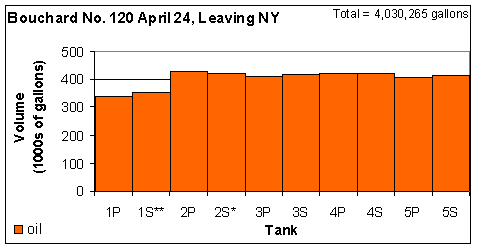
The Bouchard No. 120 tank barge leaves the Eagle Point refinery in New Jersey with more than 4,030,000 gallons of oil. (Volumes on this page are reported as Gross Standard Volume, which is the volume of the oil at room temperature).
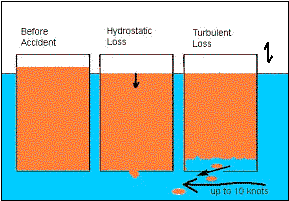
Oil left the vessel by simple hydrostatic loss (a drop of 16 inches by gravity alone) and by turbulent flow across the opening while the vessel traveled 11.5 miles in 4 foot seas to its first stop in Buzzards Bay.
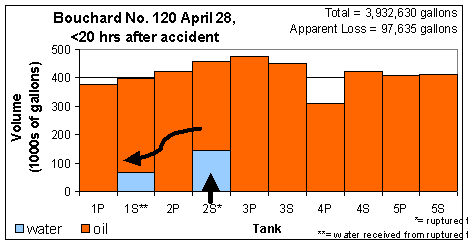
To minimize the potential for additional losses of fuel, the tank barge operators transferred oil out of the damaged tank, probably at the first site they moored at in central Buzzards Bay. In this process, some seawater was transferred as well. Twenty hours after the accident, the Bouchard No. 120 tank barge appears to have lost 97,600 gallons of oil based on measurements by inspectors, and had taken on water well in excess of the volume of oil lost.
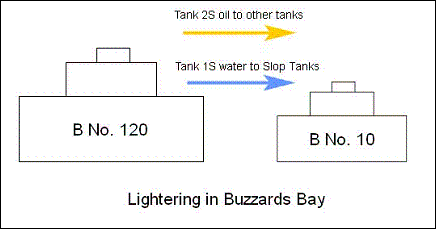
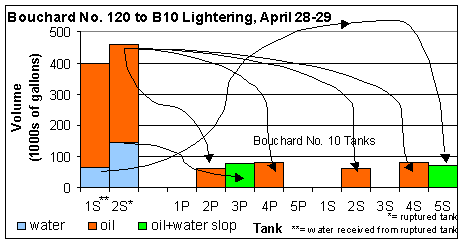
A day after the accident, another tank barge, the Bouchard No. 10, removes oil and water from two tanks on the Bouchard No. 120. The diagram above shows the likely pathways of the transfer. When the oil layer floating on the water in the damaged tank was reduced to a few inches, flow may have been diverted to “slop water” tanks on the Bouchard No. 10 referenced in their reports.
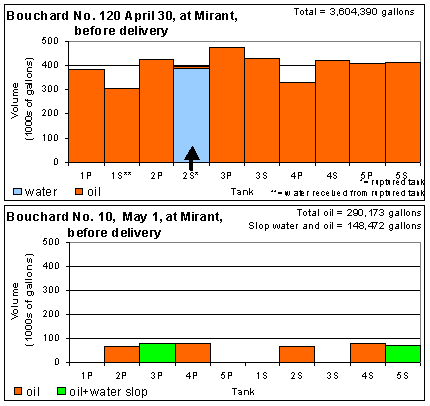
Between April 30 and May 1, the Bouchard No. 10 and Bouchard No. 120 arrive at the Mirant Canal facility, and their contents are measured. The precise quantity of oil in the Bouchard No. 10 slop tanks are not directly measured. Discrepancies in oil remaining in the Bouchard No. 120 from inspector reports suggest that 28,600 gallons of oil could have been transferred to the Bouchard No. 10 slop tanks.
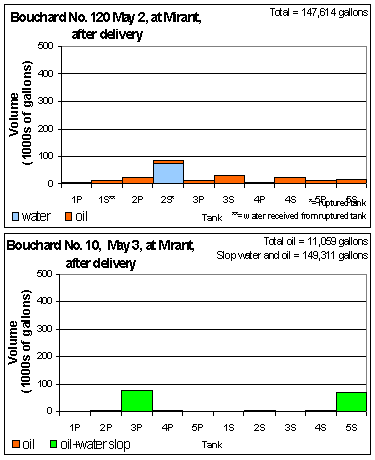
After delivering their oil, the liquids remaining on board the Bouchard No. 10 and Bouchard No. 120 are again quantified on May 2 and May 3. The volumes remaining, transfers, and shore receipts are again consistent with measurements in the previous days, and in Buzzards Bay.
Shipyard Calculations
The Bouchard No. 120 and Bouchard No. 10 travel to the Caddell Shipyards on Staten Island and the contents of all remaining liquids are removed and the tanks hot washed to remove all oil and oily sediments at the bottom of the tanks. Recognizing that the volume of oil in the slop tanks on the Bouchard No. 10 are important for confirming the volume of oil spilled, Bouchard Transportation Co. hires a consultant to evaluate the contents of the two vessels. However, throughout the month of May, the contents of the slop tanks on the Bouchard No. 10, and all the other tanks without water on the Bouchard No. 120 and No. 10 are combined, together with hot water washes used to clean the vessels. At the end of May, all the oil and water from the Bouchard No. 120 and No. 10 have been transferred to 3 shore storage tanks, and a third vessel, the Jav Bee VI. The volume of oil and water in this vessel, and the shore tanks are measured. At this point it appears that the total volume of oil collected from the two tank barges is roughly 397,100 or 397,800 gallons.
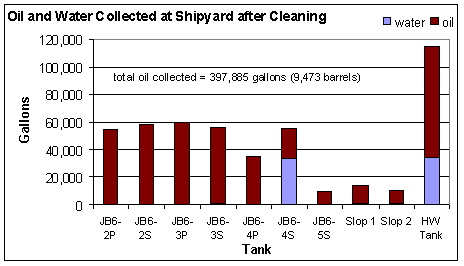
This volume is problematic, because the volume of oil in the tanks and the oil on the JavBee VI, plus the volume of oil delivered to Mirant appear to exceed the volume of oil on the vessel before the accident (397,080+3,706,057= 4,103,137 gallons, which is greater than the 4,030,265 gallons leaving New Jersey). This of course would imply that no oil was spilled in Buzzards Bay. The shipyard oil volumes do not even include some oil that was burned to heat water and some oil that was shipped out of the shipyard because it was clogging pumps.
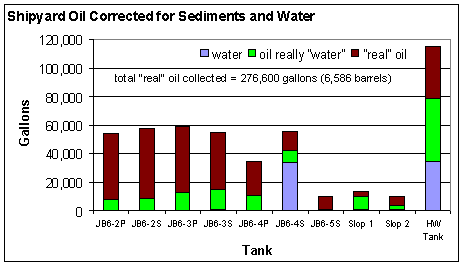
The consultant for Bouchard resolved this apparent contradiction with laboratory assays that showed that the oil layer floating on the water in each tank had a combined sediment and water content ranging from 7% to 70%. These adjustments were the basis of the calculations concluding that 22,000 to 55,000 gallons of oil were spilled in Buzzards Bay.
This approach, however, is problematic for a number of reasons. First, the corrections were made based on a single oil sample in each tank, without documentation of the depth in which the oil sample was taken. [Think of a bottle of salad dressing that has been shaken. Look at the amount of oil and water droplets at different depths.] Moreover, this correction is adjusted for “sediments,” which is actually part of the oil cargo and residual material at the bottom of the tank, and should not be subtracted. Similar corrections of oil and sediments were not made for the volume delivered to Mirant. If just 1% of the oil delivered to Mirant were “water and sediment,” an addition 37,000 gallons of oil could be presumed to have been spilled in Buzzards Bay.
Bouchard Transportation Company’s Rebuttal to the Buzzards Bay NEP’s Report
The Buzzards Bay NEP and Coast Guard received these reports and correspondence from the Bouchard Transportation Company in response to our February 2004 interim report on the volume of oil spilled in Buzzards Bay. These reports disputed our analysis.
March 18, 2004 Cover letter from Bouchard Transportation Company (13 kb pdf file)
March 17, 2004 Endorsement letter from the firm Minton, Treharne & Davies (USA), Inc. (260 kb pdf file)
March 18, 2004 Rebuttal report from David Hall, for the firm Independent Maritime Consulting. (1.4 Mb pdf file)
Response by the Buzzards Bay NEP to the Bouchard consultant’s March 18, 2004 report
In response to Independent Maritime Consulting Ltd.’s March 2004 rebuttal, the Buzzards Bay NEP prepared this letter which identified areas which we felt were inconsistent in IMC’s analysis, and ten specific information requests which were needed to validate their analysis.
April 16, 2004 response by the Buzzards Bay NEP (81 kb pdf file)
Epilogue
In the spring of 2004, the US Coast Guard Marine Safety Office in Providence sent all the aforementioned reports to the US Coast Guard Marine Safety Office in Washington, DC, and asked for a review of the information, and a determination of the best estimate of oil volume spilled. On June 29, 2004, the US Coast Guard Marine Safety Office in Washington sent a memorandum stating that they determined that the 98,000 gallon estimate based on oil water and head space levels in each of the ten compartments on the Bouchard No. 120 calculated on April 28 by the firm Caleb Brett was in fact the best estimate of the volume of oil spilled based on the uncertainties of the alternative analyses. Specifically they concluded that the revised lower estimates of oil spilled as proposed by the firm Independent Maritime Consulting Ltd. did not include “methodologies or engineering practices that are more credible than the post casualty ullages recorded by Caleb Brett.” That is to say, the 98,000-gallon estimate of oil spilled has been determined to be the most credible estimate of oil spilled in Buzzards Bay, and will remain so in the absence of any new information.
Click here to read the USCG June 29, 2004 Memorandum (208 kb) on the volume of oil spilled.
Relevance of Oil Volumes
The Buzzards Bay NEP undertook this review because it is of interest to managers who want to better understand the costs and impacts associated with a specific quantity of No. 6 oil, and how those costs compare to other spills. In Massachusetts, oil spill fines are not based on the volume of oil spill. Furthermore, the Natural Resource Damage Assessment effort will be based on actual injuries documented, not the volume of oil spilled. In a newspaper editorial, Frank Csulak, Damage Assessment Coordinator, Buzzard Bay Oil Spill for the NOAA Damage Assessment Center stated:
“Reported spill volumes are usually unreliable during an oil spill and often are not determined with accuracy even well after the incident has ended. The objective of a damage assessment is to document injuries resulting from the spill and determine appropriate types and amounts of restoration to fully compensate the public for losses to public resources. The magnitude of injuries resulting from a spill does not necessarily correspond to the volume of oil spilled…. Consequently, the trustees focus on documenting injuries to natural resources rather than confirming a particular volume of spilled oil or running an assessment based on a reported spill volume.”
The only Natural Resource Damage Assessment area where the volume has relevance is “aquatic injuries” –impacts to plant and animal life in the water column. This is because estimates of aquatic injuries depend upon predictions of toxic compounds in the water, and the computer models that predict these concentrations depend on the volume of oil entered into the model. However, this No. 6 oil did not cause the death of fish and shellfish observed in some recent and historic No. 2 oil spills, which is more toxic to animal life in the water column. Thus, even though the aquatic injury assessment for the Bouchard No. 120 spill will depend slightly on the volume of oil spilled, this damage assessment will likely be considerably less that the injury to coastal birds for example.